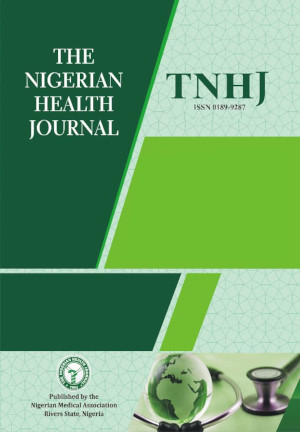Caustic Cement Burn in a Nigerian Male: A Surrogate for the State of Occupational Safety in Nigeria.
DOI:
https://doi.org/10.60787/tnhj.v14i1.132Keywords:
Caustic Cement Burn, Occupational Safety, Nigeria.Abstract
Background: Cement is an important material used in the construction industry. When mixed with water, it has abrasive, caustic and drying properties that could cause allergic and sensitivity reactions to the skin, chemical skin burns or damage to the eyes following contact. Cement burns to the skin appears to occur commonly among apprentice masons or individuals who have little knowledge about the hazards of wet cement. Rowe and Williams first reported the adverse effects of wet cement to the skin in 1963. Inadequate knowledge about possible hazards following contact with wet cement is a serious risk factor for the occurrence of caustic cement burn. The aim of this presentation is to ensure that sufficient information is made available to the public, small scale and large scale industries, to reduce and prevent future occurrence of cement burns. This would also reduce sickness absence and employee turn-over rates in industries.
Methods: The case presentation of a 37 year old male who presented with cement burns and a review of literature using Google and Medline search with the following key words; caustic cement burn; sickness absence; safety standards, personal protective equipment.
Results: This report presents the cement bum incident of a 37-year-old mason employed as a contract staff in a medium-scale construction company. He presented with a history of exposure to wet cement for a few hours which led to the occurrence of cement burns on his lower limbs.
Clinical findings revealed blister formation with swelling and pain initially, followed by formation of necrotic ulcers. There was also poor compliance of the company in keeping to safety standards and legislation. The Construction Company did not grant him a statutory sick pay claiming that their absence policies did not cover the contract staff.
Conclusion: It is possible to prevent the potential hazards of wet cement through providing sufficient information to employees and the general public and ensuring adequate use of personal protective equipment. Employers should ensure that workers are qualified for the job they are employed to carry out. Implementation of sickness absence policies and other occupational health legislation especially in small and medium-scale construction companies in Nigeria should be enforced to secure the health and safety of the workers who may not be aware of risk and hazards associated with the jobs.
Downloads

Downloads
Published
Issue
Section
License
Copyright (c) 2015 The Nigerian Health Journal

This work is licensed under a Creative Commons Attribution-NonCommercial-NoDerivatives 4.0 International License.
The Journal is owned, published and copyrighted by the Nigerian Medical Association, River state Branch. The copyright of papers published are vested in the journal and the publisher. In line with our open access policy and the Creative Commons Attribution License policy authors are allowed to share their work with an acknowledgement of the work's authorship and initial publication in this journal.
This is an open access journal which means that all content is freely available without charge to the user or his/her institution. Users are allowed to read, download, copy, distribute, print, search, or link to the full texts of the articles in this journal without asking prior permission from the publisher or the author.
The use of general descriptive names, trade names, trademarks, and so forth in this publication, even if not specifically identified, does not imply that these names are not protected by the relevant laws and regulations. While the advice and information in this journal are believed to be true and accurate on the date of its going to press, neither the authors, the editors, nor the publisher can accept any legal responsibility for any errors or omissions that may be made. The publisher makes no warranty, express or implied, with respect to the material contained herein.
TNHJ also supports open access archiving of articles published in the journal after three months of publication. Authors are permitted and encouraged to post their work online (e.g, in institutional repositories or on their website) within the stated period, as it can lead to productive exchanges, as well as earlier and greater citation of published work (See The Effect of Open Access). All requests for permission for open access archiving outside this period should be sent to the editor via email to editor@tnhjph.com.













